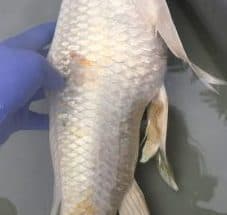An aquatic environment is an ideal growth environment for many fungi, especially water molds such as Saprolegnia. Unless your fish’s immune system is compromised, you won’t have any reason to worry about fungal disease in fish.
Fungal Species
There are thousands of potential species of fungus lurking in your aquarium or pond. Aquatic environments are ideal for fungus to grow and flourish. There are some that prefer warm water or those who thrive in cold water and can cause “winter kill.” Usually, fungus will only live on dead and decaying detritus at the bottom of your tank or pond. A simple vacuum or bottom drain will take care of these unsightly issues, but they will not hurt your fish.
Fungus and Fish
A fish’s immune system is great at defeating fungal attacks. The only time you may see fungus is if it is hanging onto a piece of dead tissue or loose scale. Without adequate blood flow to delivery immune factors, the fungus can set up shop. It will stay on the dead parts and not be able to infect the live tissues.
Fish with immune suppression can see fungus set in on live tissues. This most often occurs with common stressors, such as water quality. It is critical that any fungal infections be differentiated from Columnaris infections by your veterinarian. Columnaris is caused by a bacteria and will require very different treatment.
Treating Fungal Disease in Fish
Like ulcers on fish, fungus is most commonly secondary to some other primary stressor. Without correcting the primary cause, any treatment you use on the fungus will not last. If you have gone through our list of common fish stressors and not identified any concerns, contact your local aquatic veterinarian for additional diagnostics.

